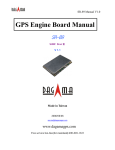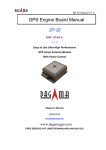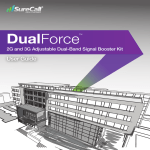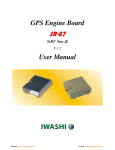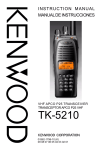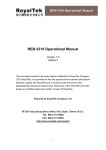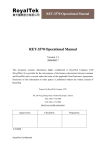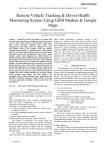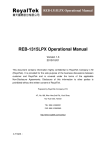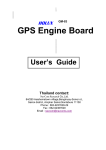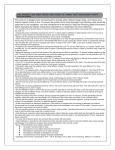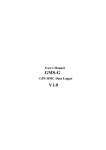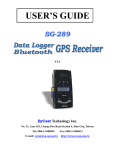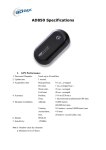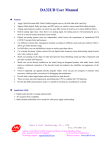Download User`s Manual
Transcript
SR-90 Manual V1.0 GPS Engine Board Manual SR-90 SiRF StarⅢ Ⅲ V 1.1 Made in Taiwan 2008/08/08 [email protected] www.dagamagps.com Free service hot-line(for mainland):400-820-1322 SR-90 Manual V1.0 Specifications subject to change without prior notice! Contents 1. Introduction 1.1 Overview 1.2 Features ……………………………………………………..…………. 2 …………………………………………………………………. 2 ……………………………………………………………………. 2 2. Technical Specifications …………………………………………………… 2 2.1. Electrical Characteristics…………………………………………………. 2 2.2. Environmental Characteristics……………………………………..……… 3 2.3. Physical Characteristics……………………………………………...…..… 4 Appendix: Software Specifications …………………………………….. 9 SR-90 User’s Manual V1.1 1 SR-90 Manual V1.0 1. Introduction 1.1 Overview SR-90 GPS module is a high performance receiver module for the Global Positioning System (GPS) solution. It combines SiRF StarⅢ GPS single chip, LNA circuit, SAW filter, oscillator, crystal and regulators into a land grid array module. The specified firmware is pre-loaded into the built-in 4-Mbit Flash memory of SR-90 for GPS application. It can be easily embedded into portable devices for GPS wireless communication. 1.2 Features SiRF starⅢ high performance GPS Chip Set Very high sensitivity (Tracking Sensitivity: -159 dBm) Extremely fast TTFF (Time To First Fix) at low signal level Compact size (25.4mm * 25.4 mm * 3.3mm) suitable for space-sensitive application One size component, easy to mount on another PCB board Support NMEA 0183 and SiRF binary protocol 2. Technical Specifications 2.1. Electrical Characteristics 2.1.1 General Frequency L1, 1575.42 MHz C/A code 1.023 MHz chip rate Channels 20 channels all in view tracking 2.1.2 Sensitivity Tracking -159 dBm typical 2.1.3 Accuracy (Open Sky) Position Time 2.1.4 Datum Default 10 meters, 2D RMS 5 meters 2D RMS, WAAS enabled 1 microsecond synchronized to GPS time WGS-84 SR-90 User’s Manual V1.1 2 SR-90 Manual V1.0 2.1.5 Acquisition Rate (Open Sky) Hot start 1 sec, average Warm start 38 sec, average Cold start 42 sec, average Reacquisition 0.1 sec, average 2.1.6 Dynamic Conditions Altitude Velocity Acceleration Jerk 18,000 meters (60,000 feet) max 515 meters/sec (1000 knots) max Less than 4 G 20 meters/sec max 2.1.7 Power Main power input Supply Current 3.3 ± 5% VDC input 68mA (Continuous mode) 2.1.8 Serial Port Electrical interface Protocol support Default NMEA TTL level NMEA-0183, SiRF Binary GGA, GSA, GSV, RMC, (GLL, VTG, and ZDA optional) 4800 baud rate (other rate optional) 8 bits data, 1 stop bit, no parity. 2.1.9 Time 1 PPS Pulse, pulse duration 1µs. Time reference at the pulse positive edge. Synchronized to GPS time, ±1µs. 2.2. Environmental Characteristics Operating temperature range Storage temperature range -40 oC to +85 oC -45 oC to +100 oC SR-90 User’s Manual V1.1 3 SR-90 Manual V1.0 2.3. Physical Characteristics Top view Pin Assignment Pin Signal Name I/O Description 1 VCC I DC Supply Voltage input 2 GND G Ground 3 Boot select I Boot mode 4567 RXA TXA TXB RXB IOOI Serial port A Serial port A Serial port B Serial port B 8 GPIO14 I/O General –purpose I/O 9 RF_ON 10 GND G Digital Ground 11 16 GND_A G Analog Ground 17 RF_IN I GPS Signal input 18 GND_A G Analog Ground 19 V_ANT_IN I Active Antenna Bias voltage 20 VCC_RF O Supply Antenna Bias voltage 21 22 V_BAT Reset II Backup voltage supply Reset (Active low) 23 GPIO10 I/O General purpose I/O 24 25 26 GPIO1 GPIO5 GPIO0 I/O I/O I/O General purpose I/O General purpose I/O General purpose I/O (support continuous power mode only) 27 GPIO13 I/O General purpose I/O I/O O G General purpose I/O One pulse per second Digital Ground 28 29 30 GPIO15 PPS GND SR-90 User’s Manual V1.1 4 SR-90 Manual V1.0 Definition of Pin assignment VCC This is the main DC supply for a 3.3V ± 5% DC input power module board. GND GND provides the ground for digital part. Boot select Set this pin to high for programming flash. RXA This is the main receiver channel and is used to receive software commands to the board from SIRFdemo software or from user written software.PS: Pull up if not used. RXB This is the auxiliary receiving channel and is used to input differential corrections to the board to enable DGPS navigation.PS: Pull up if not used. TXA This is the main transmitting channel and is used to output navigation and measurement data to SiRFdemo or user written software. TXB For user’s application (not currently used). RF_ON This pin indicates state of RF voltage. RF_IN This pin receiver signal of GPS analog .due to the RF characteristics of the signal the design has to certain criteria. The line on the PCB from theantenna (or antenna connector) has to be a controlled microstrip line at 50Ω V_ANT_IN This pin is reserved an external DC power supply for active antenna. If using 3.0V active antenna, pin 19 has to be connected to pin 20. If using 3.3V or 12V active antenna, this pin has to be connected to 3.3V or 5Vpower supply. VCC_RF This pin provides DC voltage 3.0 for active antenna. Reset This pin provides an active-low reset input to the board. It causes the board to reset and start searching for satellites. If not utilized, it may be left open. PPS This pin provides one pulse-per-second output from the board, which is synchronized to GPS time. This is not available in Trickle Power mode. Backup battery (V_BAT) SR-90 User’s Manual V1.1 5 SR-90 Manual V1.0 This is the battery backup input that powers the SRAM and RTC when main power is removed. Typical current draw is 15uA. Without an external backup battery, the module/engine board will execute a cold star after every turn on. To achieve the faster start-up offered by a hot or warm start, a battery backup must be connected. The battery voltage should be between 2.0v and 5.0v. Without an external backup battery or super cap, the TMP will execute a cold start after every power on. To achieve the faster start-up offered by a hot or warm start, either a battery backup must be connected or a super cap installed. To maximize battery lifetime, the battery voltage should not exceed the supply voltage and should be between 2.5V and 3.6V. With the super cap (B1) installed, and after at least ten minutes of continuous operation, the data retention is about seven hours. Note that even though all other components are rated at –30 to +85 deg C, a typical super cap is specified over a temperature range of –25 to +70 deg C and a typical rechargeable Lithium battery is over –20 to +70 deg C. GPIO Functions Several I/Os are connected to the digital interface connector or custom applications. Application Circuit SR-90 User’s Manual V1.1 6 SR-90 Manual V1.0 (1) Ground Planes: SR-90 GPS receiver needs two different ground planes. The GND_A pin(11、12、13、14、15、16、18) shall be connect to analog ground. The GND pin(2 、10、30) connect to digital ground. (2) Serial Interface: The Serial interface pin(RXA 、TX1、TXB 、RXB) is recommended to pull up(10KΩ). It can increase the stability of serial data. (3) Backup Battery: It’s recommended to connect a backup battery to V_BAT. In order to enable the warm and hot start features of the GPS receiver. If you don’t intend to use a backup battery, connect this pin to GND or open. If you use backup battery, shall need to add a bypassing capacitor (10uF) at V_bat trace. It can reduce noise and increase the stability. (4) Antenna: Connecting to the antenna has to be routed on the PCB. The transmission line must to controlled impedance to connect RF_IN to the antenna or antenna connector of your choice. (5) Active antenna bias voltage: The Vcc_RF pin (pin 20) is providing voltage 3.3V. If you use active antenna, you can connect this pin to V_ANT_IN pin (pin 19) to provide bias voltage of active. Mechanical Layout SR-90 User’s Manual V1.1 7 SR-90 Manual V1.0 SR-90 User’s Manual V1.1 8 SR-90 Manual V1.0 Appendix: Software Specifications NMEA Protocol The interface protocol is based on the National Marine Electronics Association (NMEA) interface specification, namely, the NMEA 0183 standard. The unit is capable of supporting the following NMEA message formats specifically developed and defined by SiRF. NMEA Message Prefix $GPGGA $GPGLL $GPGSA $GPGSV $GPMSS $GPRMC $GPVTG $GPZDA Format Direction Time, position and fix type data. Latitude, longitude, time of position fix and status. GNSS DOP and active satellites Satellites in view. Radio beacon signal-to-noise ratio, signal strength, frequency, etc. Recommended minimum specific GNSS data. Speed and course over ground. Out Out Out Out Date and time. Out Out Out Out General NMEA Format The general NMEA format consists of an ASCII string commencing with a ‘$’ character and terminating with a <CR><LF> sequence. NMEA standard messages commence with ‘GP’ then a 3-letter message identifier. The message header is followed by a comma delimited list of fields optionally terminated with a checksum consisting of an asterix ‘*’ and a 2 digit hex value representing the checksum. There is no comma preceding the checksum field. When present, the checksum is calculated as a bitwise exclusive of the characters between the ‘$’ and ‘*’. As an ASCII representation, the number of digits in each number will vary depending on the number and precision, hence the record length will vary. Certain fields may be omitted if they are not used, in which case the field position is reserved using commas to ensure correct interpretation of subsequent fields. SR-90 User’s Manual V1.1 9 SR-90 Manual V1.0 $GPGGA This message transfers global positioning system fix data. Following is an example. $GPGGA,161229.487,3723.2475,N,12158.3416,W,1,07,1.0,9.0,M, , , ,0000*18 The $GPGGA message structure is shown below: Field Message ID UTC Time Latitude N/S Indicator Longitude E/W indicator Example $GPGGA 161229.487 3723.2475 N 12158.3416 W Position Fix Indictor 1 Satellites Used 07 HDOP MSL Altitude (2) Units Geoid Separation (2) Units 1.0 9.0 M Unit 0: Fix not available or invalid. 1: GPS SPS mode, fix valid. 2: Differ. GPS, SPS mode, fix valid 3-5: Not supported. 6: Dead Reckoning Mode, fix valid. (1) Meter Meter Meter Meter Age of Diff. Corr. Diff Ref. Station ID Checksum <CR> <LF> Notes GGA protocol header. hhmmss.sss ddmm.mmmm N=north or S=south. dddmm.mmmm E=east or W=west. Second Number of satellites used to calculate fix. Range 0 to 12. Horizontal Dilution of Precision. Altitude above mean seal level. M stands for “meters”. Separation from Geoids can be blank. M stands for “meters”. Age in seconds. Blank (Null) fields when DGPS is not used. 0000 *18 Message terminator. (1) Only apply to NMEA version 2.3 (and later) in this NMEA message description. (2) SiRF does not support geoid corrections. Values are WGS84 ellipsoid heights. SR-90 User’s Manual V1.1 10 SR-90 Manual V1.0 $GPGLL This message transfers geographic position, latitude, longitude, and time. an example. Following is $GPGLL,3723.2475,N,12158.3416,W,161229.487,A,A*41 The $GPGLL message structure is shown below: Field Message ID Latitude N/S Indicator Longitude E/W indicator UTC Time Status Example $GPGLL 3723.2475 N 12158.3416 W 161229.487 A Mode A Checksum <CR><LF> *41 Unit Notes GLL protocol header. ddmm.mmmm N=north or S=south. dddmm.mmmm E=east or W=west. hhmmss.sss A: Data valid or V: Data invalid. A=Autonomous, D=DGPS, E=DR (Only present in NMEA version 3.00). Message terminator. SR-90 User’s Manual V1.1 11 SR-90 Manual V1.0 $GPGSA This message transfers DOP and active satellites information. Following is an example. $GPGSA,A,3,07,02,26,27,09,04,15, , , , , ,1.8,1.0,1.5*33 The $GPGSA message structure is shown below: Field Message ID Example $GPGSA Unit Notes GSA protocol header. Mode A M: Manual, forced to operate in selected 2D or 3D mode. A: Automatic switching between modes. Mode 3 1 2 3 Satellites Used (1) Satellites Used (1) … Satellites Used (1) PDOP HDOP VDOP Checksum <CR> <LF> 07 02 Fix not available. 2D position fix. 3D position fix. SV on channel 1. SV on channel 2. .. SV on channel 12. 1.8 1.0 1.5 *33 Message terminator. (1) Satellites used in solution. SR-90 User’s Manual V1.1 12 SR-90 Manual V1.0 $GPGSV This message transfers information about satellites in view. The $GPGSV message structure is shown below. Each record contains the information for up to 4 channels, allowing up to 12 satellites in view. In the final record of the sequence the unused channel fields are left blank with commas to indicate that a field has been omitted. Following is an example. $GPGSV,2,1,07,07,79,048,42,02,51,062,43,26,36,256,42,27,27,138,42*71 $GPGSV,2,2,07,09,23,313,42,04,19,159,41,15,12,041,42*41 The $GPGSV message structure is shown below: Field Message ID Number of messages (1) Message number Satellites in view Satellite ID Elevation Azimuth SNR (C/N0) Satellite ID Elevation Azimuth SNR (C/N0) Satellite ID Elevation Azimuth SNR (C/N0) Satellite ID Elevation Azimuth SNR (C/N0) Checksum <CR> <LF> Example $GPGSV 2 1 07 07 79 048 42 02 51 062 43 26 36 256 42 27 27 138 42 *71 Unit degree degree dBHz degree degree dBHz degree degree dBHz degree degree dBHz Notes GSA protocol header. Number of messages, maximum 3. Sequence number, range 1 to 3. Number of satellites currently in view. Channel 1, ID range 1 to 32. Elevation of satellite, maximum 90. Azimuth of satellite, range 0 to 359. Range 0 to 99, null when not tracking. Channel 2, ID range 1 to 32. Elevation of satellite, maximum 90. Azimuth of satellite, range 0 to 359. Range 0 to 99, null when not tracking. Channel 3, ID range 1 to 32. Elevation of satellite, maximum 90. Azimuth of satellite, range 0 to 359. Range 0 to 99, null when not tracking. Channel 4, ID range 1 to 32. Elevation of satellite, maximum 90. Azimuth of satellite, range 0 to 359. Range 0 to 99, null when not tracking. Message terminator. (1) Depending on the number of satellites tracked multiple messages of GSV data may be required. SR-90 User’s Manual V1.1 13 SR-90 Manual V1.0 $GPMSS This message transfers information about radio beacon signal-to-noise ratio, signal strength, frequency, etc. Following is an example. $GPMSS,55,27,318.0,100,1,*57 The $GPMSS message format is shown below. Field Message ID Signal Strength Signal-to-Noise Ratio Beacon Frequency Beacon Bit Rate Example $GPMSS 55 27 318.0 100 Channel Number (1) 1 Checksum <CR> <LF> *57 Unit Notes MSS protocol header. dB dB kHz SS of tracked frequency. SNR of tracked frequency. Currently tracked frequency. Bits per second. The channel of the beacon being used if a multi-channel beacon receiver is used. Message terminator. (1) Fields marked in italic red apply only to NMEA version 2.3 (and later) in this NMEA message description. SR-90 User’s Manual V1.1 14 SR-90 Manual V1.0 $GPRMC This message transfers recommended minimum specific GNSS data. example. Following is an $GPRMC,161229.487,A,3723.2475,N,12158.3416,W,0.13,309.62,120598, ,*10 The $GPRMC message format is shown below. Field Message ID UTC Time Status Latitude N/S Indicator Longitude E/W indicator Speed over ground Course over ground Date Magnetic variation (1) Mode (2) Checksum <CR> <LF> Example $GPRMC 161229.487 A 3723.2475 N 12158.3416 W 0.13 309.62 120598 Unit knot degree degree A *10 Notes RMC protocol header. hhmmss.sss A: Data valid or V: Data invalid. ddmm.mmmm N=north or S=south. ddmm.mmmm E=east or W=west. Speed over ground Course over ground ddmmyy, current date. Not used. A=Autonomous, D=DGPS, E=DR. Message terminator. (1) SiRF does not support magnetic declination. All “course over ground” data are geodetic WGS84 directions. (2) Fields marked in italic red apply only to NMEA version 2.3 (and later) in this NMEA message description. SR-90 User’s Manual V1.1 15 SR-90 Manual V1.0 $GPVTG This message transfers velocity, course over ground, and ground speed. example. Following is an $GPVTG,309.62,T, ,M,0.13,N,0.2,K,A*23 The $GPVTG message format is shown below. Field Message ID Course (true) Reference Course (magnetic) Reference (1) Speed Units Speed Units Mode (2) Checksum <CR> <LF> Example $GPVTG 309.62 T Unit degree degree M 0.13 N 0.2 K A *23 knot km/hr Notes VTG protocol header. Measured heading T = true heading Measured heading M = magnetic heading (1) Speed in knots N = knots Speed K = km/hour. A=Autonomous, D=DGPS, E=DR. Message terminator. (1) SiRF does not support magnetic declination. All “course over ground” data are geodetic WGS84 directions. (2) Fields marked in italic red apply only to NMEA version 2.3 (and later) in this NMEA message description. SR-90 User’s Manual V1.1 16 SR-90 Manual V1.0 $GPZDA This message transfers UTC Time and Date. Following is an example. $GPZDA,181813,14,10,2003,00,00*4F The $GPZDA message format is shown below. Field Message ID Example $GPZDA Unit Notes ZDA protocol header. UTC Time 181813 Either using valid IONO/UTC or estimated from default leap seconds. UTC Day UTC Month UTC Year Local zone hours Local zone minutes Checksum <CR> <LF> 14 10 2003 00 00 *4F 01 to 31, day of month. 01 to 12. 1980 to 2079. Offset from UTC (set to 00). Offset from UTC (set to 00). Message terminator. All Rights Reserved SR-90 User’s Manual V1.1 17


















